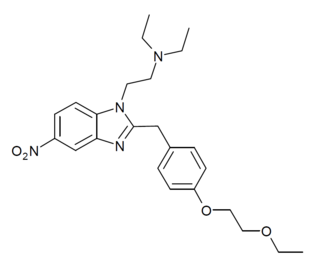
Piperidylthiambutene (Piperidinohton) is a synthetic opioid analgesic drug from the thiambutene family, which has around the same potency as morphine. Piperidylthiambutene is structurally distinct from fentanyl, its analogues, and other synthetic opioids previously reported. If sold or obtained for the purpose of human consumption it could be considered a controlled substance analogue in some countries such as the US, Australia and New Zealand. Piperidylthiambutene has been sold as a designer drug, first appearing in late 2018.

Butyrfentanyl or butyrylfentanyl is a potent short-acting synthetic opioid analgesic drug. It is an analog of fentanyl with around one quarter of its potency. One of the first mentions of this drug can be found in document written by The College on Problem of Drug Dependence, where it is mentioned as N-butyramide fentanyl analog. This document also states that the article describing its clinical effects was published in 1987. It is an agonist for the μ-opioid receptors.

U-47700, also known as U4, pink heroin, pinky, and pink, is an opioid analgesic drug developed by a team at Upjohn in the 1970s which has around 7.5 times the potency of morphine in animal models.

Furanylfentanyl (Fu-F) is an opioid analgesic that is an analog of fentanyl and has been sold as a designer drug. It has an ED50 value of 0.02 mg/kg in mice. This makes it approximately one fifth as potent as fentanyl.

Acrylfentanyl (also known as acryloylfentanyl) is a highly potent opioid analgesic that is an analog of fentanyl and has been sold online as a designer drug. In animal studies the IC50 (the half maximal inhibitory concentration for acrylfentanyl to displace naloxone) is 1.4 nM, being slightly more potent than fentanyl itself (1.6 nM) as well as having a longer duration of action.

Metonitazene is an analgesic compound related to etonitazene, which was first reported in 1957, and has been shown to have approximately 1000 times the potency of morphine by central routes of administration, but if used orally it has been shown to have approximately 10 times the potency of morphine.

Isotonitazene is a benzimidazole derived opioid analgesic drug related to etonitazene, which has been sold as a designer drug. It has only around half the potency of etonitazene in animal studies, but it is likely even less potent in humans as was seen with etonitazene. Isotonitazene was fully characterized in November 2019 in a paper where the authors performed a full analytical structure elucidation in addition to determination of the potency at the μ-opioid receptor using a biological functional assay in vitro. While isotonitazene was not compared directly to morphine in this assay, it was found to be around 2.5 times more potent than hydromorphone and slightly more potent than fentanyl.

Etonitazepyne is a benzimidazole derivative with potent opioid effects which has been sold over the internet as a designer drug and linked to numerous cases of overdose.

ADB-4en-PINACA is a cannabinoid designer drug that has been found as an ingredient in some synthetic cannabis products, first appearing in early 2021. It is a reasonably potent cannabinoid agonist in vitro but has not been so widely sold as related compounds such as ADB-PINACA and MDMB-4en-PINACA.

AP-238 is an opioid designer drug related to drugs such as azaprocin and bucinnazine, with around the same potency as morphine. It was first discovered in Italy in the 1960s but was never marketed, subsequently appearing on the illicit market around 2020 and being detected in both Slovenia and the USA.

Butyrnorfentanyl or butyrylnorfentanyl is an inactive synthetic opioid analgesic drug precursor. It is an analog of fentanyl.

Remifentanilic acid is a metabolite of the potent short-acting synthetic opioid analgesic drug remifentanil. It is an analog of fentanyl and remifentanil, but is not active as an opioid in its own right.

Protonitazene is a benzimidazole derivative with potent opioid effects which has been sold over the internet as a designer drug since 2019, and has been identified in various European countries, as well as Canada, the USA and Australia. It has been linked to numerous cases of drug overdose, and is a Schedule I drug in the USA.

Butonitazene is a benzimidazole derivative with opioid effects, which has been sold over the internet as a designer drug. It has relatively low potency compared to many related compounds, and has generally been encountered as a component of mixtures with other substances rather than in its pure form. However, it is still several times the potency of morphine and has been implicated in several cases of drug overdose. Butonitazene is a Schedule I drug in the USA, along with several related compounds.

para-Fluorofuranylfentanyl is an opioid analgesic that is an analog of fentanyl and has been sold as a designer drug. As with other fentanyl analogues, parafluorofuranylfentanyl has significant side effects including itching, nausea and potentially serious respiratory depression, which can be life-threatening, and it has been linked to numerous deaths from overdose. It falls within the definition of Schedule I drugs in the USA under federal drug analogue legislation, and is specifically listed as a Schedule I drug in North Dakota.

N-Desethylisotonitazene (Norisotonitazene) is a benzimidazole derivative with potent opioid effects which has been sold as a designer drug. It was first identified as an active metabolite of the related compound isotonitazene, but was unexpectedly found to be similar potency compared to the parent compound, and is among the most potent opioid agonists in this family, around 20 times stronger than fentanyl. It has become an increasingly widespread drug of abuse in its own right, linked to numerous cases of drug overdose,and may be considered an analog of a schedule 1 drug in the US. On October 25 an intent to temporarily schedule Etonitazepipne and N-desethyl Isotonitazene was published. So on November 24 a month after publishing intent, it will most likely be placed in schedule 1.
Utopioids are a class of synthetic opioid analgesic drugs first developed in the 1970s by the pharmaceutical company Upjohn. However, they were never marketed for medical use. Some compounds from this class have been used for scientific research as model kappa opioid receptor agonists. In the mid-2010s, one mu opioid receptor selective compound from this class, U-47700, re-emerged as a designer drug and became widely sold around the world for several years before being banned in various jurisdictions from 2016 onwards. Following the prohibition of U-47700, a number of related compounds have continued to appear on illicit drug markets. They are often marketed online or included as components in mixtures sold under the guise of "street heroin." U-47700 itself is the most potent mu opioid agonist from this class, around 7-10x the potency of morphine. Some other compounds such as 3,4-MDO-U-47700 and N-Ethyl-U-47700 retain similar mu selectivity but with lower potency similar to that of morphine, or have a mixture of mu and kappa mediated effects, such as U-48800. Most utopioid derivatives are however selective kappa agonists, which may have limited abuse potential as dissociative hallucinogens, but do not alleviate withdrawal distress in opioid dependent individuals or maintain addiction in a typical sense. Nevertheless, this has not stopped them from being sold as designer drugs, and a number of these compounds are now banned in many jurisdictions alongside U-47700 itself.

Etoetonitazene is a benzimidazole derivative with opioid effects, first developed in the 1950s as part of the research that led to better-known compounds such as etonitazene. It is an analogue of etonitazene where the ethoxy group has been extended to ethoxyethoxy. It is less potent than etonitazene itself, but is still a potent opioid agonist with around 50x the potency of morphine, and has been sold as a designer drug since around 2022.

Flunitazene (Fluonitazene) is a benzimidazole derivative with opioid effects, first developed in the 1950s as part of the research that led to better-known compounds such as etonitazene. It is one of the least potent derivatives from this class to have appeared as a designer drug, with only around the same potency as morphine, but nevertheless has been sold since around 2020, and has been linked to numerous drug overdose cases.


















